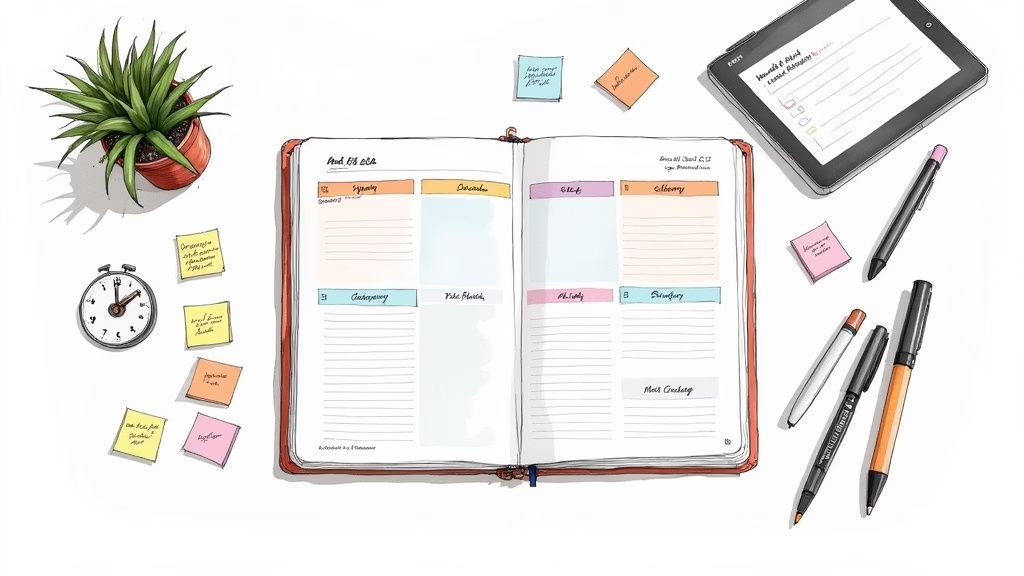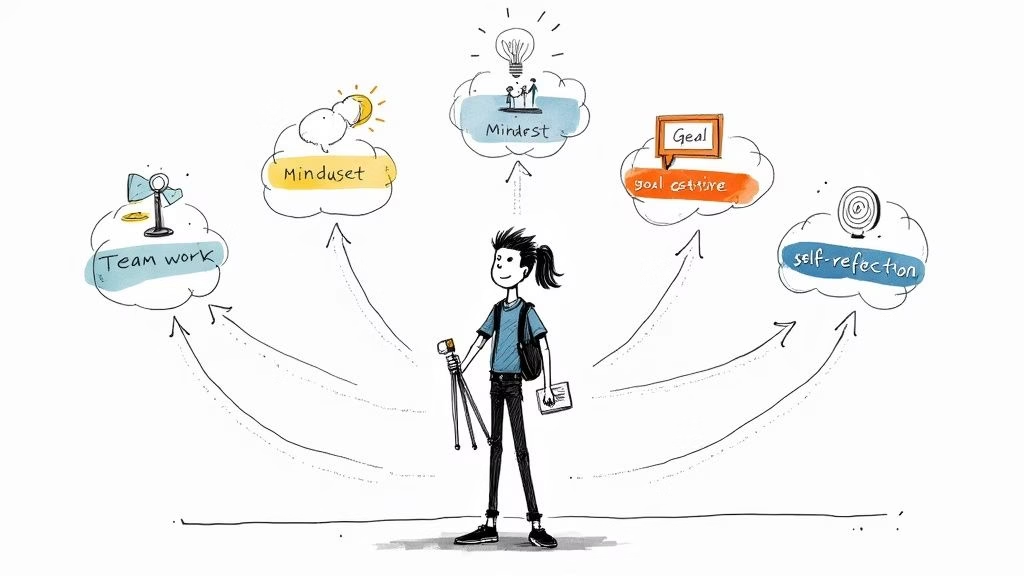Let’s be honest: managing your time in school can feel completely impossible. It’s more than just buying a planner and hoping for the best. Real, lasting time management is about getting to the root of why things feel so overwhelming in the first place—it’s about tackling procrastination, motivation, and your own mental well-being head-on.
When you build a system that works with your brain instead of against it, you stop seeing time as an enemy. It becomes a tool to help you find balance, crush your goals, and actually reduce your stress.
Why Managing Your Time in School Feels Impossible
If you’ve ever stared at a mountain of assignments and felt paralyzed, you’re not alone. That feeling is a universal student experience. But the typical advice to “just be more organized” completely misses the point. The real reasons you struggle have very little to do with being lazy.
It’s almost always tied to the psychology of motivation, the intense pressure of school, and the sneaky ways procrastination takes over.
This guide is different. We’re not going to talk about finding more hours in the day—that’s impossible. Instead, we’re going to focus on mastering your energy and focus with strategies that are actually built for real student life.
To give you a clearer picture of what we’ll cover, here’s a quick look at the common struggles students face and the solutions we’re going to unpack.
Common Student Roadblocks and Practical Solutions
| The Challenge You’re Facing | The Strategy We’ll Explore |
|---|---|
| Feeling constantly overwhelmed and not knowing where to start. | Breaking down massive goals into small, manageable steps. |
| Procrastinating on important assignments until the last minute. | Using the Eisenhower Matrix to separate what’s urgent from what’s important. |
| Juggling classes, homework, a social life, and maybe a job. | Time blocking your schedule to create dedicated focus periods. |
| Getting easily distracted by your phone or other interruptions. | Designing a study environment that minimizes distractions and boosts focus. |
| Struggling with focus and motivation, especially with ADHD. | Adopting ADHD-friendly techniques like the Pomodoro method and body doubling. |
| Feeling burned out, anxious, or stressed all the time. | Prioritizing rest, self-care, and building a sustainable support system. |
Each of these points represents a hurdle that can feel insurmountable, but with the right approach, you can learn to navigate them effectively and take back control of your time.
The Real Reasons You Procrastinate
Procrastination isn’t just “putting things off.” It’s an emotional reaction to feeling stressed, anxious, or overwhelmed. For a lot of students, the fear of not doing a perfect job or the sheer dread of a difficult subject makes avoidance feel like the only safe option.
It’s a coping mechanism, but a brutal one. It traps you in a cycle of last-minute panic, rushed work, and feeling terrible about the results.
And if this sounds familiar, it’s because it’s incredibly common. Research shows that around 75% of college students are regular procrastinators, a habit that’s deeply connected to struggles with emotional regulation. The behavior is so widespread that 58% of students admit to submitting work within 24 hours of the deadline, even when they had plenty of time. You can dig into more productivity and time management statistics to see just how prevalent this is.
Connecting with Mental Health and Support
The constant pressure to perform, get good grades, and plan for the future takes a huge toll on teen mental health. When that academic stress becomes chronic, it can quickly lead to burnout, anxiety, and a total loss of motivation. Just admitting this link exists is the first real step toward building a healthier relationship with your work.
Managing your time is also about managing your well-being. Scheduling breaks, protecting your sleep, and asking for help aren’t luxuries—they are non-negotiable parts of any successful academic plan.
For parents, understanding this is everything. Instead of just nagging about deadlines, try opening a conversation about the pressures your student is facing. Encourage them to connect with resources like school counselors or other trusted professionals who can give them tools to manage anxiety and build resilience.
When you create an environment where it’s safe to say, “I’m overwhelmed,” it becomes much easier for students to ask for help before they hit a breaking point.
Find Your Motivation and Set Goals You Care About
Let’s be honest. It’s almost impossible to manage your time well when you couldn’t care less about the outcome. A perfectly color-coded planner means nothing if you have zero motivation to actually follow through. This is why finding your “why” isn’t just a fluffy concept—it’s the single most important part of time management for any student.
You can’t force motivation. It has to hook into something you genuinely want for yourself. It’s the difference between dragging yourself through a required reading versus losing track of time while researching a project that actually fascinates you.

So, before you even think about calendars and to-do lists, ask yourself a simple question: What do I actually want to achieve this semester? Your answer is the fuel that will get you through late-night study sessions and boring assignments. It’s how you beat procrastination before it even starts.
Make Your Goals Matter to You
You’ve probably heard of SMART goals (Specific, Measurable, Achievable, Relevant, Time-bound). It’s a solid framework, but it can feel a little too corporate and stiff for student life. The key is to make it your own, and the most important part of that is Relevance. Your goals have to connect to what you value and where you want to go.
A generic goal like “get good grades” is vague and uninspiring. Let’s make it personal:
- Specific: “I want to get an A in my calculus class.”
- Measurable: “To do that, I need to score at least 90% on the last two exams and all my homework.”
- Achievable: “I’ll block out an hour every Tuesday and Thursday just for practice problems, and I’ll go to office hours every week.”
- Relevant: “Nailing calculus is non-negotiable for my engineering major application, and that’s a future I’m genuinely excited about.”
- Time-bound: “This is my goal for this semester, which ends December 15th.”
See the difference? A vague wish just became a concrete, actionable plan. The process itself builds momentum because you can finally see a clear path forward. If you want to dive deeper into this, our guide on goal setting for teenagers breaks down practical steps to figure out what you truly want.
Break Down Intimidating Goals
A huge, semester-long goal can feel like trying to climb a mountain in one step. That feeling of overwhelm is what triggers procrastination. The trick is to break it down into smaller, more manageable pieces.
If your goal is to write a 20-page research paper, that thought alone is enough to make you want to go watch Netflix.
Instead, chop it up into weekly—or even daily—tasks:
- Week 1: Choose a topic and get it approved.
- Week 2: Find and organize ten credible sources.
- Week 3: Write a detailed outline.
- Week 4: Draft the introduction.
Suddenly, “write a 20-page paper” turns into “find ten sources this week.” That’s a task you can actually start and finish. Each small win gives you a hit of accomplishment and builds the momentum you need to keep going.
Overwhelm is the enemy of motivation. By breaking large projects into bite-sized tasks, you make progress feel immediate and tangible, which is a powerful psychological tool against procrastination.
A Parent’s Role in Fostering Motivation
Parents can be a huge help in this process, but it requires a shift from directing to guiding. Instead of the classic, “Did you finish your homework?” try asking, “What was one thing you learned today that you found interesting?” That small change shifts the focus from compliance to curiosity.
Here are a few tips for parents:
- Encourage Ownership: Let your teen set their own goals, even if they seem small to you. That sense of autonomy is absolutely essential for building internal motivation.
- Celebrate the Process, Not Just the Outcome: Praise their hard work on a tough project, regardless of the final grade. This reinforces resilience and teaches them that genuine effort is what truly matters.
- Connect School to Their Interests: If your kid loves video games, help them see how their coding class could lead to a career in game design. Making those connections gives schoolwork a purpose beyond the classroom.
Mental Health and Academic Motivation
It’s crucial to acknowledge that a persistent lack of motivation can sometimes be a red flag for underlying mental health challenges like anxiety or depression. Research consistently shows a direct link between a student’s mental well-being and their ability to stay engaged with school. The pressure to succeed can be crushing, leading to burnout that often gets mistaken for laziness.
If you notice your student is consistently unmotivated, withdrawn, or more irritable than usual, it’s time to open up a conversation about their mental health. Creating a safe environment where it’s okay to talk about these struggles is one of the most important things you can do for their long-term success. Reputable resources like the National Institute of Mental Health (NIMH) offer excellent guidance for both teens and parents.
Create a Plan That Works for You
Let’s be real: a rigid, minute-by-minute schedule is a recipe for disaster. Student life is anything but predictable. One surprise quiz or a last-minute project change can throw your whole week into chaos. So, the goal isn’t to control every second of your day. It’s to build a flexible system that brings some clarity and intention to the madness.
This means getting past a simple to-do list and actually using tools that force you to decide what really matters. It’s about learning to make smart decisions on the fly, so you can handle the curveballs without everything falling apart.
This infographic breaks down a simple cycle for creating a study schedule that actually works.
The key here isn’t just the planning—it’s the cycle of planning, doing, and reviewing. That’s what keeps your schedule from becoming irrelevant after a week.
Master the Art of Prioritization
Not all tasks are created equal. This is a hard lesson to learn. Answering a few emails feels productive, sure, but it does absolutely nothing to move the needle on that massive term paper. To make real progress, you have to learn the difference between what’s urgent and what’s truly important.
A game-changing tool for this is the Eisenhower Matrix. It forces you to sort your tasks into four simple quadrants:
- Urgent & Important (Do it now): This is crisis mode. Think studying for a test that’s tomorrow or finishing an essay due at midnight. These are the fires you have to put out.
- Not Urgent & Important (Schedule it): This is where success is built. This quadrant is all about long-term planning, chipping away at big projects, and building good study habits.
- Urgent & Not Important (Delegate it): These are the interruptions—the requests from others or pointless meetings that don’t align with your actual goals.
- Not Urgent & Not Important (Delete it): Mindless scrolling on TikTok, Netflix binges, and other time-wasters that you know you should cut.
When you sort your to-do list this way, it becomes painfully obvious where your energy should be going. Most students live in Quadrant 1, constantly stressed and putting out fires. The real goal is to spend more time in Quadrant 2, proactively working on the things that will actually shape your future.
Tackle Your Most Dreaded Task First
Procrastination almost always boils down to one thing: the dread of a single, challenging, or mind-numbingly boring task. It just hangs over your day, sucking up mental energy even when you’re trying to work on something else. The solution is brutally simple: Eat the Frog.
The technique is based on a Mark Twain quote and the idea is this: identify your single most difficult task for the day—your “frog”—and do it first thing. No excuses.
When you get your hardest task out of the way before anything else, you get this incredible surge of accomplishment. That momentum makes everything else on your list feel so much easier in comparison.
Let’s say you’ve been putting off the research for your history paper. Make that your frog. Before you even think about checking your phone, dedicate your first focused hour of the day to finding and organizing sources. Once it’s done, that mental weight is gone, and you can tackle the smaller stuff with a clear head.
A Note for Parents on Planning
As a parent, your instinct is probably to jump in and create a schedule for your student. I get it, but trust me, it rarely works. Your role here is to be a guide and a sounding board, not a manager.
- Ask Guiding Questions: Instead of telling them what to do, try asking things like, “What’s the one thing on your list that’s stressing you out the most?” or “Honestly, how much time do you think you’ll really need for that assignment?”
- Encourage Buffer Time: Teens are notoriously bad at estimating how long things take. Gently remind them to schedule in some “buffer time”—empty blocks in their calendar—to handle the assignments that turn out to be way harder than they looked.
- Support Their Mental Health: Sometimes, an inability to plan is a symptom of something deeper, like anxiety or feeling completely overwhelmed. A student’s well-being comes first. Fostering an environment where it’s safe to say “I’m struggling” is far more helpful than trying to enforce a rigid schedule they can’t stick to. Resources from organizations like the Child Mind Institute can offer great guidance here.
Beat Procrastination and Avoid Student Burnout
Procrastination and burnout are the two biggest monsters hiding under a student’s bed. I see them all the time. They look like separate issues, but they’re deeply connected. Procrastination isn’t just laziness—it’s an emotional reaction to feeling stressed, anxious, or terrified of not being good enough.
This cycle of putting things off, followed by a last-minute panic, is completely draining. When it happens over and over, it creates a direct path straight to burnout. Getting a handle on these challenges is about more than just willpower; it takes real strategies to stop procrastinating and build habits that protect your mental health before you hit a wall.

Unpacking the Psychology of Procrastination
At its core, procrastination is an emotional regulation issue, not a time management one. When you’re staring down a task that feels huge, boring, or just plain hard, your brain screams for an escape. So you switch to something more pleasant, giving you a temporary mood boost. The problem is, you’re just creating a debt that your future self has to pay back, with serious interest.
This cycle is incredibly powerful, and understanding why you do it is the first step to breaking free. There’s a clear link between how students manage their time and how engaged they feel in school. A study of over 1,000 college students found that those with better time management skills were way more involved in their academic work. You can explore more of the findings on student engagement and time management yourself.
Actionable Strategies to Fight Procrastination
Knowing why you procrastinate is one thing, but you need actual tools to fight back when the urge to watch YouTube hits. Instead of waiting for motivation to magically appear, you can use a few simple tricks to get your brain started.
- The Pomodoro Technique: This is a classic for a reason. You use a timer to work in focused bursts—traditionally 25 minutes—followed by a short break. It’s effective because it shrinks the task. You’re not committing to “study for three hours”; you’re just committing to 25 minutes. Anyone can do that.
- The 2-Minute Rule: If something takes less than two minutes, just do it. Right now. For bigger tasks, the idea is to shrink the first step to two minutes. Instead of “write my essay,” the task becomes “open the document and write one sentence.” Getting over that initial hurdle is usually the hardest part.
These strategies aren’t just about getting more done; they’re about building momentum. Each small win gives you a little hit of dopamine, making it easier to keep the ball rolling. For a much deeper dive, check out our guide on how to stop procrastinating for more detailed methods.
Recognizing and Preventing Student Burnout
Burnout is more than just feeling tired. It’s a state of chronic physical and emotional exhaustion. For students, it usually comes from the relentless pressure to perform, combined with bad sleep habits and zero separation between school and personal life.
Burnout is what happens when you’ve been running on empty for far too long. Scheduling intentional rest isn’t a luxury or a reward—it’s a fundamental part of a sustainable plan for school.
Learning to spot the early warning signs is everything.
- Warning Signs of Burnout:
- Feeling cynical or totally detached from your classes.
- A constant lack of motivation, even for subjects you used to love.
- Being more irritable, anxious, or feeling hopeless.
- Physical symptoms like headaches, exhaustion, or trouble sleeping.
If any of this sounds familiar, it’s a signal to act now. Protecting your sleep, making time for hobbies you actually enjoy, and setting firm boundaries—like not checking school emails after 9 PM—are non-negotiable.
Mental Health Resources and Parental Support
A student’s mental well-being is the foundation for everything. You can’t manage your time if you’re drowning in anxiety or depression. It’s so important for students and parents to know where to turn for help.
- JED Foundation: An organization focused on protecting emotional health and preventing suicide for teens and young adults.
- The Trevor Project: Provides crisis intervention and suicide prevention services specifically for LGBTQ young people.
- Active Minds: A nonprofit that supports mental health awareness and education directly for students on campus.
Parents, you play a huge role here. Instead of adding more pressure about grades, try to create an environment where it’s safe to talk about stress. Model healthy habits yourself by taking breaks and prioritizing your own well-being. The goal isn’t to solve their problems for them, but to empower them with the resilience and resources to manage challenges on their own.
The Best Apps and Tools for Staying Organized
The right tech can feel like a superpower when you’re trying to stay on top of your classes. It can turn a chaotic mess of deadlines and assignments into a clear, actionable plan. But with a million apps out there, the trick is finding tools that actually make your life simpler, not just add another thing to check.
We’ll look at a few digital powerhouses that are perfect for students, but we’ll also talk about why sometimes, a good old-fashioned planner or whiteboard still wins.
The secret to solid time management for students is having one central place where you can see everything. That’s why a good calendar app is completely non-negotiable.
Digital Calendars: Your Central Hub
Think of a digital calendar as the command center for your entire semester. You’re not just plugging in due dates; you’re blocking out time for study sessions, scheduling group project meetings, and even reminding yourself to call home. It’s about seeing the whole picture.
Google Calendar is a fantastic, free option that plays nicely with just about every other platform you’ll use.
- Here’s how it works in real life: Maria gets the syllabi for her five classes on the first day of the semester. Before she does anything else, she opens Google Calendar and creates a separate, color-coded calendar for each course. She spends ten minutes plugging in every major exam, project deadline, and presentation date. Just like that, she has a visual map of her busiest weeks and can see potential conflicts coming from a mile away. No more last-minute surprises.
Task Managers: Track Your Deadlines
A calendar tells you when something is due. A task manager shows you how you’re actually going to get it done. These apps are built to take a huge, overwhelming project and break it down into small, manageable steps—a proven strategy for beating procrastination.
Todoist is a clean, simple, and surprisingly powerful tool for this. My favorite part is its natural language input, which makes adding tasks ridiculously fast.
- Here’s how it works in real life: Alex has a massive research paper due in three weeks. Instead of just adding “Write History Paper” to his list (which is basically a recipe for panic), he opens Todoist and creates a new project. He breaks it down: “Choose topic,” “Find 10 sources,” “Create outline,” “Write introduction,” and “Draft first section.” He gives each small task its own due date. Now, instead of one scary deadline, he has a clear roadmap to get him to the finish line.
Note-Taking Platforms: Connect Your Ideas
Your notes, research links, and class materials shouldn’t be scattered across a dozen different Word docs and random folders. A unified note-taking app can become your personal brain, connecting ideas from different classes and projects.
Notion is the definition of an all-in-one workspace. It lets you create notes, databases, and project boards. I’ll be honest, it has a steeper learning curve, but once you get the hang of it, the flexibility is incredible.
One of the biggest time-sucks for any student is just trying to find stuff. Having a single, organized digital home for all your notes and research will save you countless hours over a semester.
- Here’s how it works in real life: Sarah uses Notion to create a template for her biology lab reports. It has sections for her hypothesis, methods, data, and conclusion. She can drop in links to research articles, connect to related lecture notes, and even create a checklist for each step of the experiment. Everything for that single project lives on one clean, organized page.
Don’t Underestimate Analog Tools
Even with all this amazing tech, sometimes the simplest tool is the best one. For a lot of people, the physical act of writing something down makes it stick in your brain in a way that typing just doesn’t.
A simple whiteboard or a physical planner can be incredibly effective.
- Here’s how it works in real life: Every Sunday night, Leo grabs a marker and writes his top three priorities for the week on a large whiteboard above his desk. Seeing those big-picture goals written in bold, unmissable letters keeps him focused. When he finishes a major task, he gets the satisfaction of physically erasing it—a small, powerful feeling of accomplishment that a digital click can’t always match. This simple ritual keeps his most important goals front and center all week long.
A Parent’s Guide to Supporting Your Student
Great time management skills often take root at home, with a solid support system. As a parent, your goal isn’t to become a micromanager, dictating every move your student makes. Think of yourself as a coach. You’re there to help them build the muscles of independence and resilience, not to do the reps for them.
The idea is to guide, not control. This empowers them to take real ownership of their schoolwork and, eventually, their life.
Your actions are often the most powerful lesson you can teach. When you model healthy habits—like setting boundaries with your own work, making rest a priority, and talking openly about managing stress—you’re showing them how it’s done in the real world. Instead of the classic, “Is your homework finished?” try shifting the conversation to something like, “What’s your game plan for that big project?” This small tweak encourages strategic thinking, not just blind compliance.
Fostering Independence And Motivation
Let’s get one thing straight: procrastination is rarely about laziness. More often than not, it’s a symptom of feeling completely overwhelmed or anxious. Study after study shows a direct link between a teen’s mental health and how engaged they are in school. When a student feels crushed by pressure, their brain’s ability to plan and execute simply shuts down.
Here’s how you can step in as their coach:
- Break It Down Together: If a huge assignment is looming, sit down with them and help break it into smaller, bite-sized pieces. Just seeing a massive task become a series of manageable steps can make all the difference.
- Focus on Effort, Not Just Grades: Praise their hustle and persistence, especially when they’re tackling a tough subject. This builds a growth mindset and shows them that their hard work matters more than the final letter grade.
- Create a Safe Space to Talk: Make it clear that it’s okay to feel stressed out. It’s normal. Sometimes, the most powerful support you can offer is just listening without jumping in to solve everything.
A supportive conversation about stress will always be more productive than a lecture about deadlines. When students feel heard and understood, they’re far more likely to ask for help before things hit a crisis point.
Mental Health Resources For Teens
Knowing when and where to find professional help is key. If you’re noticing persistent signs of anxiety, withdrawal, or burnout in your teen, it might be time to bring in extra support. These organizations offer incredible guidance for both you and your student.
- The JED Foundation: A fantastic resource focused on protecting the emotional health of teens and preventing suicide.
- Child Mind Institute: Offers a deep well of information on teen mental health, learning disorders, and effective strategies.
By building a supportive partnership, you create the foundation your student needs to truly thrive. For more ideas on how to do this, check out our guide on empowering parents with coaching tools for enhancing teen engagement.
A Few Common Questions I Hear All The Time
Even with the best game plan, you’re going to hit roadblocks. It happens. Here are some of the most common questions I get from students and parents, along with some real-world advice to get you unstuck.
How Can Parents Help Without Taking Over?
This is a big one. As a parent, you want to help, but you don’t want to become a micromanager. The best way to do this is to shift from being a manager to being a coach.
Instead of laying out a schedule for them, try asking open-ended questions like, “What’s your plan for that big project?” This approach builds their sense of independence and ownership.
Your main job is to create a home environment where it’s okay to talk about stress without judgment. Let’s be honest, procrastination is almost always tied to anxiety. Research consistently shows a powerful link between a teen’s mental health and how engaged they are at school.
The single most powerful thing you can do as a parent? Model healthy habits yourself. When your kid sees you openly managing your own stress and making rest a priority, it teaches a lesson far more impactful than any lecture on deadlines ever could.
What Do I Do if I Lose All My Motivation Mid-Semester?
First off, it’s completely normal for your drive to take a nosedive halfway through the term. Everyone feels it. When it happens, the first thing to do is reconnect with your “why.”
Go back to those big-picture goals you set at the beginning of the semester—the ones that actually got you excited. Reminding yourself what you’re working toward can be a powerful motivator.
Next, break down what’s left to do into the smallest, most manageable steps you can think of. The idea here is to create a series of quick, easy wins to start rebuilding your momentum.
It’s also crucial to check in on your mental health. A persistent lack of motivation can be a red flag for burnout. Don’t just push through it. Organizations like the JED Foundation offer fantastic support for student well-being. This isn’t just about getting through the semester; it’s about building habits for a healthy, sustainable life.
At Andrew Petrillo Life Coaching, I help students develop the exact skills they need to beat procrastination and feel confident in how they manage their time. If you’re ready to turn that feeling of overwhelm into focused action, you can learn more about how I work at https://andrewpetrillolifecoaching.com.



